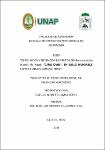| dc.contributor.advisor | Romero Villacrez, Juan Luis | es_PE |
| dc.contributor.author | Zumba López, Carlos Alberto | es_PE |
| dc.date.accessioned | 2021-01-06T14:31:58Z | |
| dc.date.available | 2021-01-06T14:31:58Z | |
| dc.date.issued | 2018 | |
| dc.identifier.uri | http://repositorio.unapiquitos.edu.pe/handle/20.500.12737/6940 | |
| dc.description.abstract | La presente investigación se realizó con el objetivo de controlar la retención de frutas
de Myrciaria dubia “Camu camu” con niveles de Ácido Giberelico 3 y como también
la variación de la época de reproducción de la misma con defoliación química, en la
región de Loreto, Perú.
La investigación fue de tipo cuantitativo, prospectivo, transversal, analítico y de nivel
explicativo. Para determinar el efecto de los niveles de ácido giberelico y época de
reproducción, se seleccionaron 48 plantas de 7 años, siendo seleccionadas en forma
aleatoria, de las cuales 24 fueron defoliadas, y las otras 24 no fueron sin defoliación,
aplicándose a todos ellos el ácido giberelico. Las características evaluadas fueron:
número de flores, número de frutas retenidas en fase 3, número de frutas retenidas
en la fase 5, número de frutas caídas en la fase 3 y peso de frutas (g). Los resultados
nos muestran que hay superioridad en número de flores al haber defoliación por
estimulación de la misma.
La defoliación promovió un mayor porcentaje de frutas retenidas en la (T2) fase 3, y
en la (T4) fase 5 hay una marcada retención de frutas donde no se hizo defoliación y
dosificación de AG3. Existe una natural caída critica de frutas, siendo abundante
entre la (T6) fase 1- 3. Hubo alteración fisiológica por defoliación y aplicación de AG3
y se reflejan negativamente en los pesos de frutas.
Respecto a fenología de las plantas que fueron defoliadas ocurrió a los 170 días,
desde la floración a la cosecha, mientras en las no defoliadas fue de 247 días,
consiguiendo adelantar la época de cosecha. Bajo condiciones de manejo con
dosificación con AG3 y defoliación, las plantas responden de manera diferente sin
significancia alguna y en la cosecha las frutas muestran iguales características para
ambas fenologías. | es_PE |
| dc.description.abstract | The present investigation was carried out with the objective of controlling the retention
of Myrciaria dubia "Camu camu" fruits with levels of Gibberellic Acid 3 and also the
variation of the reproduction season of the same with chemical defoliation, in the
Loreto region, Peru.
The research was quantitative, prospective, cross-sectional, analytical and
explanatory. To determine the effect of gibberellic acid levels and reproduction
season, 48 7-year-old plants were selected, being randomly selected, of which 24
were defoliated, and the other 24 were not without defoliation, applying to all of them
the gibberelic acid. The evaluated characteristics were: number of flowers, number of
fruits retained in phase 3, number of fruits retained in phase 5, number of fallen fruits
in phase 3 and fruit weight (g). The results show us that there is a superiority in the
number of flowers as there is defoliation due to its stimulation.
Defoliation promoted a higher percentage of fruits retained in (T2) phase 3, and in
(T4) phase 5 there is a marked retention of fruits where defoliation and dosage of AG3
were not done. There is a natural critical fall of fruits, being abundant between (T6)
phase 1-3. There was physiological alteration due to defoliation and application of
AG3 and they are negatively reflected in the fruit weights.
Regarding the phenology of the plants that were defoliated, it occurred at 170 days,
from flowering to harvest, while in the non-defoliated plants it was 247 days, managing
to advance the harvest season. Under management conditions with dosing with AG3
and defoliation, the plants respond differently without any significance and at harvest
the fruits show the same characteristics for both phenologies. | es_PE |
| dc.format | application/pdf | es_PE |
| dc.language.iso | spa | es_PE |
| dc.publisher | Universidad Nacional de la Amazonía Peruana | es_PE |
| dc.rights | Attribution-NonCommercial-NoDerivs 3.0 United States | es_PE |
| dc.rights | info:eu-repo/semantics/openAccess | es_PE |
| dc.rights.uri | http://creativecommons.org/licenses/by-nc-nd/3.0/us/ | * |
| dc.source | Repositorio institucional - UNAP | es_PE |
| dc.source | Universidad Nacional de la Amazonía Peruana | es_PE |
| dc.subject | Defoliación | es_PE |
| dc.subject | Caida prematura de frutos | es_PE |
| dc.subject | Camu camu | es_PE |
| dc.subject | Myrciaria dubia | es_PE |
| dc.subject | Zona húmeda | es_PE |
| dc.title | Defoliación y retención de frutos de Myrciaria dubia
(Kunth) Mc Vaugh “camu camu”, en suelo inundable
distrito Belén, Loreto, Perú | es_PE |
| dc.type | info:eu-repo/semantics/bachelorThesis | es_PE |
| thesis.degree.discipline | Agronomía | es_PE |
| thesis.degree.grantor | Universidad Nacional de la Amazonía Peruana. Facultad de Agronomía | es_PE |
| thesis.degree.name | Ingeniero(a) Agrónomo | es_PE |
| thesis.degree.program | Presencial | es_PE |
| dc.subject.ocde | http://purl.org/pe-repo/ocde/ford#4.01.06 | es_PE |
| renati.author.dni | 5293204 | |
| renati.advisor.dni | 5250812 | |
| renati.type | http://purl.org/pe-repo/renati/type#tesis | |
| renati.discipline | 811036 | |
| renati.level | http://purl.org/pe-repo/renati/level#tituloProfesional | es_PE |
| renati.juror | Urrelo Correa, Juan Imerio | |
| renati.juror | Vargas Fasabi, Jorge Aquiles | |
| renati.juror | Ramirez Chung, José Francisco | |


